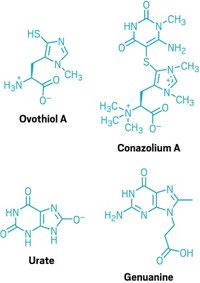Advertisement
Grab your lab coat. Let's get started
Welcome!
Welcome!
Create an account below to get 6 C&EN articles per month, receive newsletters and more - all free.
It seems this is your first time logging in online. Please enter the following information to continue.
As an ACS member you automatically get access to this site. All we need is few more details to create your reading experience.
Not you? Sign in with a different account.
Not you? Sign in with a different account.
ERROR 1
ERROR 1
ERROR 2
ERROR 2
ERROR 2
ERROR 2
ERROR 2
Password and Confirm password must match.
If you have an ACS member number, please enter it here so we can link this account to your membership. (optional)
ERROR 2
ACS values your privacy. By submitting your information, you are gaining access to C&EN and subscribing to our weekly newsletter. We use the information you provide to make your reading experience better, and we will never sell your data to third party members.
Biological Chemistry
Lamprey Pheromone Mixture Identified
Sulfated steroids from larvae attract adult sea lampreys to spawning streams
by Celia M. Henry
October 10, 2005
| A version of this story appeared in
Volume 83, Issue 41

CHEMICAL ECOLOGY
The components of the pheromone mixture that sea lampreys use to find their way to spawning streams have been identified by a team of biologists and chemists at the University of Minnesota, Twin Cities. The researchers hope to use the compounds as part of a program to control the invasive parasitic fish, which survives by attaching itself to larger fish and then sucking their juices.
Early last century, the sea lamprey invaded the Great Lakes and destroyed the commercial fishing populations.
Only a relatively few streams in the Great Lakes region are appropriate for lamprey spawning. Adult lampreys find these streams by answering the call of a soup of pheromones emitted by lamprey larvae, which live between three and 20 years in the spawning streams before metamorphosing into adults.

Biologist Peter W. Sorensen has spent more than a decade trying to figure out just what's in that soup. Now, Sorensen, chemistry professor Thomas R. Hoye, graduate student Jared M. Fine, and coworkers have identified three sulfated steroids, two of which were previously unknown (Nat. Chem. Biol., published online Oct. 2, dx.doi.org/10.1038/nchembio739). One of the components, petromyzonal sulfate, had been previously identified.
The most important of the steroids is petromyzonamine disulfate (PADS), which contains an aminopropyl lactam structural subunit that has never previously been seen as part of a natural product. The researchers deduced the structure by mass spectrometry and NMR spectroscopy and verified it by chemical synthesis. PADS is structurally related to squalamine, an antibiotic produced by the dogfish shark.
The lamprey olfactory system is so sensitive that it detects these compounds at subpicomolar concentrations. Each larva, therefore, emits only a tiny amount, so getting enough of the steroids to determine the structure was difficult. Fine extracted the steroids from the water in an 8,000-L laboratory tank containing on the order of 35,000 larvae buried in the mud at the bottom.
Each of the compounds elicits a response from adult lampreys, but the combination is much more powerful than are the individual compounds. Sorensen isn't sure whether they'll try to use all three compounds in lamprey control or just the most active one. The mixture could be used to lure lampreys into traps or streams that are unsuitable for spawning. Field trials with pheromone extract are already under way, Sorensen says.
To reach concentrations that lampreys respond to, only about 500 g of the compounds would be needed in the total volume of water that flows over Niagara Falls in a month, Hoye says. The current synthesis isn't up to producing such large quantities of the steroids, but Hoye isn't worried. He is confident that his team can work out a few of the bugs that make our current synthesis not efficient enough for large-scale production, he says.
 |






Join the conversation
Contact the reporter
Submit a Letter to the Editor for publication
Engage with us on Twitter